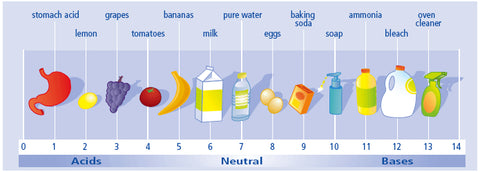Coolant is a chemical, and understanding its chemistry is key to making it last.
One key component is its alkalinity. Alkalinity refers to the pH of coolant, a topic we touched on back in Topic 101.
All aqueous solutions (those containing water) are categorized as either acidic or alkaline. Water itself is neutral. The word acid comes from the Latin word for sour, like lemons, while the word alkaline comes from the Arabic word for wood ash.
Topic 101 discussed pH, a measure of acidity and alkalinity. pH refers to the amount of hydrogen ions in the solution. The more hydrogen ions, the lower the pH value. Conversely, the fewer the hydrogen ions, the higher the pH value. Water is neutral, having a pH of 7. Thus, acidic solutions have a pH lower than 7, and alkaline solutions have a pH higher than 7. You may have experienced this ionic activity first hand if you’ve observed how a strong acid eats away anything it touches, including steel. Or, on the other hand, you may have accidentally poured bleach on your best shirt and seen the result of a strong alkali.

Importance of Coolant pH
Coolant is intentionally designed to be above neutral, with a pH in the 8-10 range, so it is alkaline. Chemists know that bacteria are present everywhere, including in our water supply, on materials we machine, and on our skin. As bacteria grow, reproduce and die, they produce a variety of acids (some of which act upon our nose). These acids interact with the coolant, and given enough bacteria and enough time, this will cause the pH of the coolant to drop. If you detect the drop, then it’s time to take action.
Maintaining the coolant’s chemical balance helps maintain the coolant/water emulsion, provides resistance to corrosion of metals, and helps to balance the effects of bacteria and fungi. Measuring pH is an effective way to maintain this aspect of coolant’s chemical balance.
Begin with a Clean Machine
It’s important to have a clean machine and sump before charging it with fresh fluid. Bacteria are so small that they creep into every nook and cranny (and their nooks and crannies). Not only does the machine sump need to be cleaned, but also the machine interior, and most of all, the fluid lines. Otherwise, the fresh coolant will be exposed to the same bacteria which allowed the previous batch to go rancid.
Most coolant suppliers offer a cleaner compatible with their coolant. In some cases it can be mixed right into the coolant so production can be maintained during the cleaning process. Otherwise, a water solution containing 10% bleach may be used, making sure to drain the tank and flood lines first. Don’t do this during machining operations, however. In all cases the coolant and machine vendors should be consulted before implementing any of these procedures.
Cleaning cycles vary, but a minimum four hours is recommended. It is important to also make sure the cleaner gets into all these nooks and crannies, even if done manually with a spray hose. After everything is cleaned, drain the cleaning solution from the tank and fluid lines. Next is a rinse cycle, using water only. Run the minimal amount of water through the flood lines and spray machine interiors well. This should be done for approximately half the time of the cleaning cycle.
Once complete, check the
of the rinse bath. Since water is neutral, the rinse bath should be a pH of 7, at minimum. If it is lower, then there are still too many bacteria vacationing in the machine somewhere! Rather than exposing the fresh and healthy coolant to these bacteria, add the cleaner to this rinse bath and repeat cleaning for half the time of the rinse cycle.
Rinse again, and keep repeating until you get a rinse bath with a pH of 7. In most cases, only one repeat cycle is necessary. However, even if it takes two or three repeat cycles to get the results you want, the time is well spent.
Preventive maintenance protocols will then keep the coolant and tank as bacteria- free as cosmically possible, extending the life of the fluid substantially.
Conclusion
Pay attention to pH!
- When initially charging the machine, make sure the sump is as clean as possible and that the cleaning fluid has a pH that is within the range recommended by the coolant vendor.
- Use preventive coolant maintenance protocols to keep the sump as bacteria-free as possible.
- Monitor pH at least once a week, but as often as you must to ensure your coolant is always in its proper zone. And when it is not, take action against bacterial growth and coolant rancidity.
Although biocides are sometimes formulated into coolant concentrate to extend shelf life, they aren’t recommended as sump additives. Biocides kill bacteria and fungi by interfering with their metabolism. However, their metabolism and human metabolism are similar, and that’s why biocides aren’t healthy for humans, particularly with extended and frequent use. It is best to use safer methods to decrease their likelihood of growth and prevent health and safety concerns.
